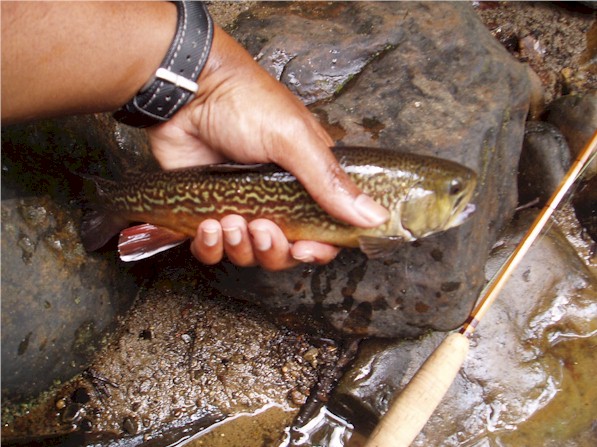|
|
|
|
|
August 19 2006- Dunbar Creek, PA. Time:
1:00pm - 3:30pm Return to Dunbar Creek. Itís been a few years since Iíve written about Dunbar Creek. This doesnít mean havenít been, I have, itís just that every so often I get too busy to write or post a report. Iím glad to report that good things are happening at Dunbar. The regs have been changed to catch and release since I last visited. The portion of the stream that I fish has always been fly fishing only but it seems that the local trout club or TU chapter has been taking things slowly. This is as it should be in a place like this, where locals were once known to net and blast fish. Change hurts and the processes of change, if it is truly to change is often a slow one.
The next step, I understand, is to close the road leading to the stream from the main ďhighwayĒ- little more than a narrow two way mountain road. Personally, Iíll miss the access that the road provides but I understanding the reasoning. The locals like to whoop it up in the stream and presumably making the access harder will deter poachers and party goers. Whatís wrong with party goers you say? Well, beyond the obvious trash such as beer cans, thereís the thrashing of the stream and stream side vegetation, destroying habitat for a trout stream that in itís upper reaches still holds native, wild Brook Trout. Thereís also the general mayhem that goes along with a bunch of rowdy drunken folks, which Iím guessing is where Dunbar Creek got most of itís undesirable reputation. The same thing happened to Pleasant Valley Creek, south of South Lake Tahoe. The owner used to provide open access to folks. It was designated a Fly Fishing preserve. Unfortunately, Fly Fishers werenít the only folks to visit and the place became a hangout for partying campers and college keg parties. The result- the owner closed the area completely. Fly Fishing is still allowed but it is a pay to play site now. I caught my first trout there..... and I miss it. So by now youíre wondering ďyeah, but how was the fishing.Ē The fishing was ok. The stream was very low, much lower than I have ever fished it. Most of the fish seemed to be grouped behind the small man made weirs. I do fish these weirs but prefer to fish the water in between them. This was tough as the water was very low, as I said before, and there wasnít much holding water. Despite this, Iím quite pleased. I managed to catch 2 trout in an hour or hour and a half. One at one of the weir pools but more importantly, one between the pools. This last fish will stay with me for quite some time.
After a long time trying, I had finally hooked and landed a fish at the first weir pool. Iíd fished my way up to the pool without a strike and without seeing a fish. I figured the weir pool would be the perfect lab to experiment with presentations and flies and figure the fish out. When I first approached, the fish werenít too active. I threw on my standards. First the Caddis Cripple, then the Elk Hair Caddis and lastly the parachute Adams. Each fly represents a particular insect or a particular life cycle of an insect. More importantly to me though, each had a different impression on the water. The Adams floats very low, representing a mayfly trapped in the surface film. The Caddis Cripple represents a caddis fly trapped in the surface film but floats a little higher than the Adams. The EHC floats the highest of all. The Cripple is my best fly on this stream and when it doesnít work, a Gulper Special has always worked in the past. Unfortunately, I didnít have any gulper specials and after the few active fish in the pool rejected each and every offering. I figured that size was probably more important. The cripple received a few looks and just as many rejections. I could see the fish working but couldnít see what they were working on. Since an annoying midge had been buzzing around my head, I put on a Griffiths Gnat. I continued again with my current trend of fishing two dry flies. When I fish droppers I usually do so by tying the second fly on at the bend of the hook of the first fly. Some folks feel this impedes hook ups; my feeling is that the other ways affect drift and how the point fly floats down stream. I think this more so with a dry dropper rig than a nymph rig. My feeling about the nymph rig is that I lose contact with the fly. Iíve tried this rig many times and each and every time Iíve improved my hook ups by switching to the dropper on hook bend method. Still, there are a couple variations of the nymph method I have yet to try and will be doing so soon. This day I fished the Caddis Cripple with a size 20 Griffiths Gnat tied on at the hook bend. I cast the Griffiths Gnat in, what I guessed, would be the path of a fairly active fish Iíd been watching and sure enough, game on! I was pretty excited, it looked to be a decent fish and it would be nice to land a Brook Trout in a native stream for a change. When the fish actually came to hand I had the surprise of my life. A Tiger Trout! Iíd never actually seen a Tiger Trout before, let alone caught one. For those who donít know. The Tiger Trout is the result of cross breeding a Brook Trout with a Brown Trout. I doubted that this was a natural occurrence. Both Brook Trout and Brown Trout live in the stream and are Fall spawners but Iíve got to imagine that the natural occurrence of this is extremely rare; if not, half the waters in the Easter Sierra would be filled with Tiger Trout.
Once I figured out the pattern; I moved away from the weir and headed further upstream. This was the first time that I fished the 7Ē6í Payne 100 3 piece rod that I made last year with a dry fly. Down at the casting ponds I didnít like it but here on the water, making short quick casts to likely holding water, letting my fly drift a foot or two and casting again, I loved it. For efficiency sake, I cast to only the best looking runs, those that looked deep and cold or fast and oxygenated or hopefully both. Almost immediately, I almost trampled a good fish. The water was much deeper than it looked. On the next similar run I didnít make the same mistake. At this time of year, all the ďrunsĒ in the stream were short and small. This one was no different. No longer than 3 or 4 feet long and 18 inches wide, this run had a basketball sized rock on the left and a smaller rock on the right which formed a small plunge. Behind the larger rock was a small section of flat water and to the right of the smaller rock a small riffle. I figured the fish would be in the slow water behind and under the larger rock. I made a cast directly behind the rock first, just to make sure there wasnít a fish further back and then shot a cast to the plunge. The flies landed perfectly, just to the inside of the large rock. The drift was good and the fly floated right past my presumed perfect lie and back to me. Wham! A fish slammed the fly as it entered the tail out. It was another Tiger Trout. Itís amazing how strong these fish were in such shallow water and adverse conditions. They are very hearty fish it would seem. The water had to be in the high 60s, but these fish were unfazed. Iím sure they would have fought long and hard if Iíd let them and they seemed to revive very quickly.
This would be my last fish of the day. I moved up stream to a pretty good pool by a large rock. It was filled with fish. I entertained several small strikes from smaller fish but allowed them to spit out the barbless hook without striking. Just ahead was the last and largest of the weir pools. As a approached, two other anglers swept down the bank and set up shop. They didn't move into the spot in a rush to get there first, they simply didn't know I was there. I continued upstream behind them. We talked and I watched as they fished the pool. It turns out that they hadn't caught any fish, so my two tigers were looking pretty good. It also turns out that one of the fellows was an acquaintance of mine that I'd never met. When I first wrote about Dunbar some years ago, this fellow asked if he could add me to a link on his web site. He did and we shared some nice emails. Turns out he was one of the guys.
Previous Eastern Mountain Stream Chronicle Next Eastern Mountain Stream Chronicle
|





